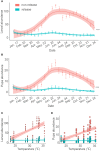Ecology, invasion history and biodiversity-driven management of the coconut black-headed caterpillar Opisina arenosella in Asia
- PMID: 37051087
- PMCID: PMC10084852
- DOI: 10.3389/fpls.2023.1116221
Ecology, invasion history and biodiversity-driven management of the coconut black-headed caterpillar Opisina arenosella in Asia
Abstract
The coconut black-headed caterpillar (BHC), Opisina arenosella Walker (Lepidoptera: Xyloryctidae) is an important herbivore of palm trees that originates in South Asia. Over the past decades, O. arenosella has spread to several countries in Eastern and Southeast Asia. BHC larval feeding can cause severe defoliation and occasional plant death, resulting in direct production losses (e.g., for coconut) while degrading the aesthetic value of urban and rural landscapes. In this review paper, we systematically cover taxonomy, bio-ecology, invasion history and current management of O. arenosella throughout Asia. Given that O. arenosella is routinely controlled with insecticides, we equally explore options for more sustainable management through agroecological and biodiversity-based tactics e.g., cultural control or biological control. Also, recent advances in chemical ecology have unlocked lucrative opportunities for volatile-mediated monitoring, mating disruption and mass-trapping. Substantial progress has been made in augmentation biological control, with scheduled releases of laboratory-reared parasitoids lowering BHC infestation pressure up to 95%. Equally, resident ants provide 75-98% mortality of BHC egg masses within the palm canopy. Biological control has been effectively paired with sanitary measures and good agronomy (i.e., proper fertilization, irrigation), and promoted through participatory farmer training programs. Our comprehensive listing of non-chemical preventative and curative tactics offer bright prospects for a more environmentally-sound, biodiversity-driven mitigation of a palm pest of regional allure.
Keywords: agroecology; biological control; coconut black-headed caterpillar; crop protection; ecological intensification; invasion biology; natural enemies.
Copyright © 2023 Lu, Lyu, Tang, Wu, Wyckhuys, Le, Chongchitmate, Qiu and Zhang.
Conflict of interest statement
Author KW is the chief executive officer of Chrysalis Consulting, a firm that provides tailored support to nature-friendly agriculture and biological control. The remaining authors declare that the research was conducted in the absence of any commercial or financial relationships that could be construed as a potential conflict of interest.
Figures


Similar articles
-
Chalcidid parasitoids (Hymenoptera: Chalcididae) of Opisina arenosella (Walker) (Lepidoptera: Xyloryctidae) on coconut palm in southern India.Zootaxa. 2024 Nov 12;5537(4):493-510. doi: 10.11646/zootaxa.5537.4.3. Zootaxa. 2024. PMID: 39645734
-
Direct and indirect influences of intercrops on the coconut defoliator Opisina arenosella.J Pest Sci (2004). 2018;91(1):259-275. doi: 10.1007/s10340-017-0904-6. Epub 2017 Aug 9. J Pest Sci (2004). 2018. PMID: 29367842 Free PMC article.
-
Predicting the geographical potential distribution of species Opisina arenosella Walker in China under different climate scenarios based on the MaxEnt model.Bull Entomol Res. 2024 Oct;114(5):682-690. doi: 10.1017/S0007485324000464. Epub 2024 Oct 2. Bull Entomol Res. 2024. PMID: 39354873
-
Pest Status, Bio-Ecology, and Area-Wide Management of Mirids in East Asia.Annu Rev Entomol. 2024 Jan 25;69:393-413. doi: 10.1146/annurev-ento-121322-015345. Epub 2023 Sep 27. Annu Rev Entomol. 2024. PMID: 37758221 Review.
-
Agro-ecological options for fall armyworm (Spodoptera frugiperda JE Smith) management: Providing low-cost, smallholder friendly solutions to an invasive pest.J Environ Manage. 2019 Aug 1;243:318-330. doi: 10.1016/j.jenvman.2019.05.011. Epub 2019 May 15. J Environ Manage. 2019. PMID: 31102899 Review.
Cited by
-
Integrated genomic and proteomic analysis of local Bacillus thuringiensis isolates for targeted insect pest control and functional insight.Arch Microbiol. 2025 Jul 11;207(9):193. doi: 10.1007/s00203-025-04388-y. Arch Microbiol. 2025. PMID: 40643607 No abstract available.
-
Potential distribution of three invasive agricultural pests in China under climate change.Sci Rep. 2024 Jun 13;14(1):13672. doi: 10.1038/s41598-024-63553-3. Sci Rep. 2024. PMID: 38871779 Free PMC article.
References
-
- Alam M. (1962). “A list of insects and mites of eastern Pakistan,” in Report of the agriculture department (Dhaka, Bangladesh: ast Pakistan Govt Press.), (pp. 107).
-
- Archna K., Abhilasha V., Nidhi W., Prajjalendra B., Asfiya Z. (2013). Impact of synomones on foraging response of larval parasitoid, Bracon brevicornis . Ann. Plant Prot. Sci. 21, 77–82.
-
- Bach P. D. (1962). An analysis of successes in biological control of insects in the Pacific Area. Proc. Hawaiian Entomol. Soc. 18, 69–79.
-
- Baitha A., Jalali S. K., Rabindra R. J., Venkatesan T., Rao N. S. (2003). Host preference of the pupal parasitoid, Tetrastichus howardi (Olliff) (Hymenoptera: Eulophidae). J. Entomology Res. 27, 293–296.
Publication types
LinkOut - more resources
Full Text Sources
Miscellaneous

